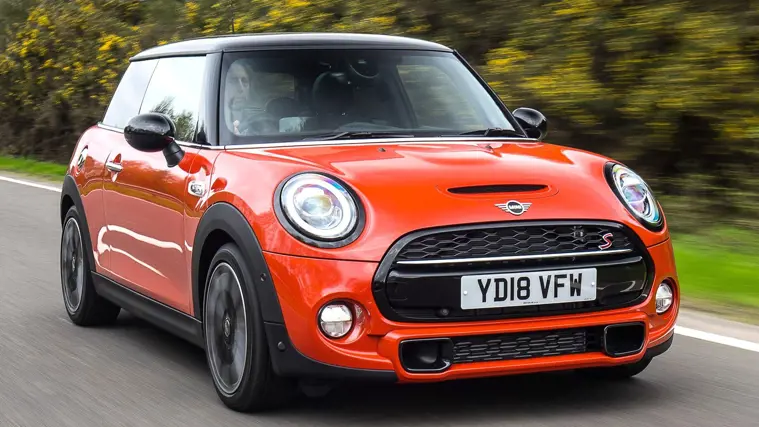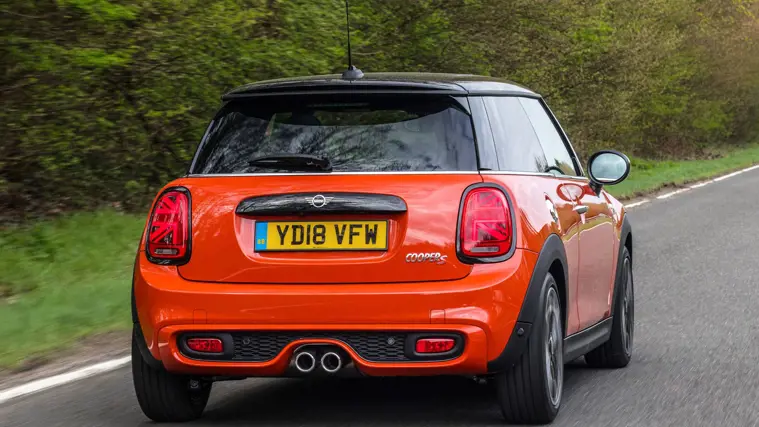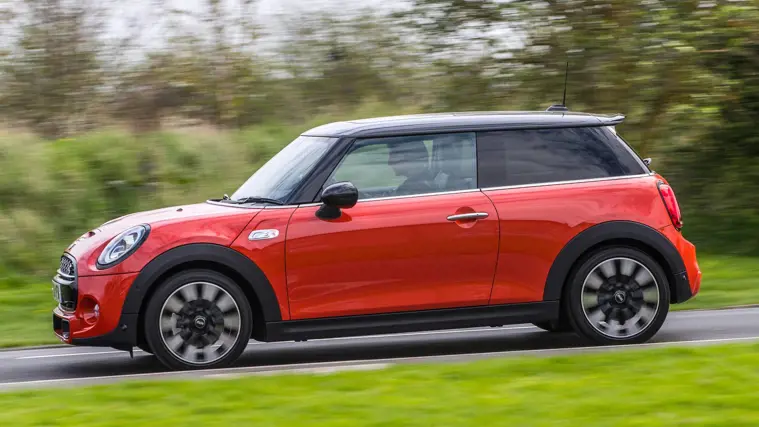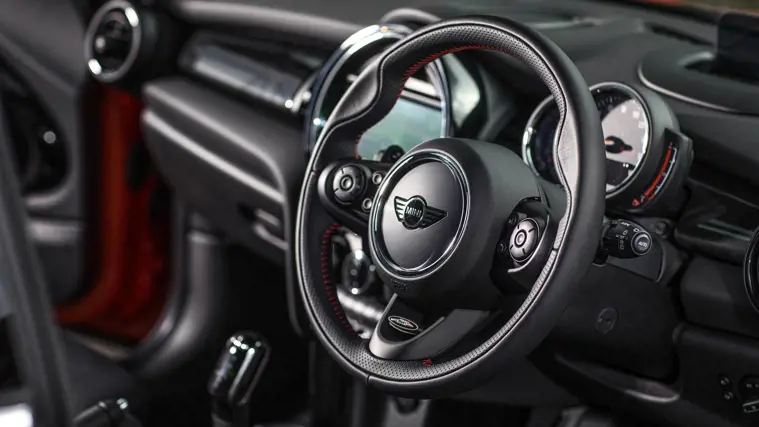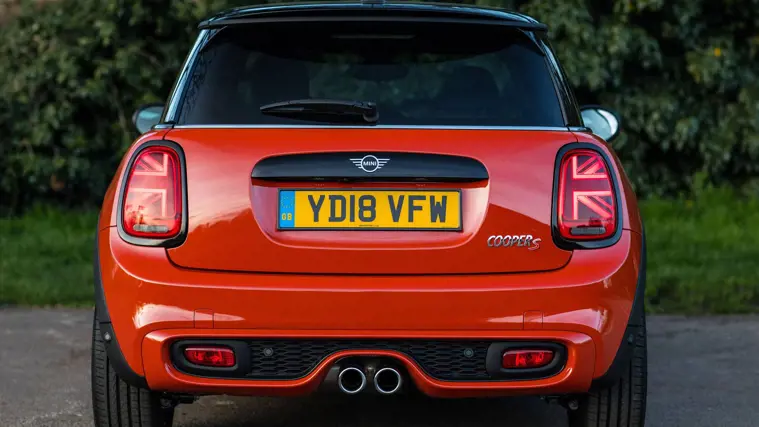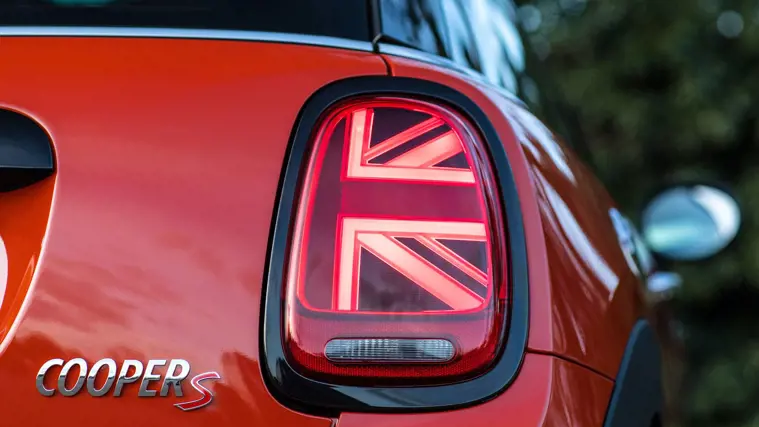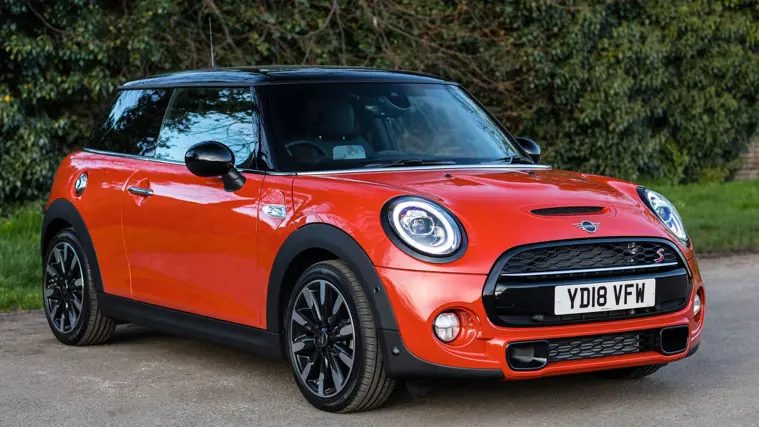MINI Hatchback Review
The fun, Mini three-door hatchback is one of the most stylish small cars you can buy
Strengths & weaknesses
- Fun to drive
- Designer-vibe interior
- Engines give good performance and economy
- Four-star safety rating
- Fairly cramped back seats
- Disappointing safety rating
Mini Hatchback prices from £7,999 Finance from £194.62 per month
It’s been almost 60 years since the Mini first brought its cheeky charm to the roads with its petite proportions, round headlamps that stared back at you like Twiggy’s eyes and a driving experience that could put a smile on your face – at least when everything was working smoothly.
The modern, British-built car might be considerably larger and, thankfully, less temperamental but it remains one of the most characterful cars on the road. It stands out from most of its supermini competitors including the Ford Fiesta, Audi A1 and Volkswagen Polo, despite costing little more to own.
The hatchback comes in three and five-door forms. Both have been updated for 2019 with a new range of trim levels for cars ordered from October 2018. Here, we’re reviewing the three-door Mini. It costs from £16,190 but Mini fans could spend up to £24,330 for a Cooper S in Exclusive trim with an automatic gearbox. Should they wish, they also could spend a lot more on wheel upgrades, personalisation, individual options and bundled option packs.
In an attempt to simplify the choice for any Mini customer, the company has introduced three trim levels, renamed its options packs and only offers three petrol engines.
It means you pick an engine – from a frugal 1.5-litre petrol in the One, to the scalding hot 2.0-litre in the John Cooper Works – decide on a manual or automatic gearbox and then choose between Classic, Sport or Exclusive trim levels. To these, buyers can add individual options or pick from options packs.
If you think the Mini three-door hatch looks distinctive on the outside, wait until you slide behind the steering wheel. The interior is a highlight of the small car, with expressive design, impressive build quality and a fun feeling that every journey is going to be, well, a mini-adventure.
A circular screen surround dominates the dashboard, just above retro toggle switches and high-quality plastics that can be finished in a range of colours including piano-black with an illuminated blue Union Jack emblem that enable you to personalise the car to your taste and budget. It all feels pleasingly sophisticated.
Arguably, only the Fiat 500 and Volkswagen Beetle offer anything approaching the Mini’s design aesthetic but none can match the Mini on the road. Mini talks up the car’s so-called go-kart feel. Sure enough, few other cars put a smile on your face like this one; whether you’re in the very cheapest Mini One or the popular Mini Cooper.
The petrol engines produce a perky exhaust note and power the car forward with real enthusiasm but even burbling around town at slower speeds can be fun.
However, it’s twisty roads where the engine can be revved smoothly for maximum power and the Mini’s quick, accurate steering sends it darting from one bend to the next, with plenty of grip from the tyres and barely any lean, that are most likely to make you grin. Few other superminis are as agile.
However, it comes at a price. The stiff suspension that gives the car its responsive feel isn’t forgiving over potholes and rough surfaces, making the ride uncomfortable. The Ford Fiesta and Seat Ibiza have some of the Mini’s agility, with less of the discomfort.
Unless you opt for the longer five-door Mini Hatchback (or the larger Mini Clubman), you’ll also have to accept that the Mini is not very practical. There are only two seats in the back and space is at a premium, so passengers had better prepare for a snug fit.
At least there’s a good number of storage spaces for bottles, small bags, sunglasses and phones but the boot lags behind the competition. The 211 litres of space on offer is just big enough for a medium weekly shop but there are more than 100 litres more in the Seat Ibiza, Volkswagen Polo and Honda Jazz.
There’s another area where the Mini lags behind its closest competitors. Its independent safety rating awarded by Euro NCAP is just four stars from a possible five. Common safety equipment, such as airbags, is standard but an automatic emergency braking system, which can help avoid or reduce the severity of a crash, is only an option with the £800 Driving Assistant Pack.
The car has three sets of Isofix points for securely mounting a child seat: two in the back and one on the front passenger seat, where, depending on the type of seat and the age of the child, the airbag may need to be switched off.
Key facts
| Warranty | Three years/unlimited miles |
|---|---|
| Boot size | 211 litres |
| Width | 1727mm |
| Length | 3821-3850mmmm |
| Height | 1414mm |
| Tax (min to max) | £165 to £205 in first year, £140 thereafter |
Best MINI Hatchback for...
Best for Economy – Mini One Automatic
When paired with an automatic gearbox, the entry-level 1.5-litre petrol engine returns up to 55.4mpg and emits as little as 117g/km of CO2. No diesel engine is available in the latest Mini range.
Best for Families – Mini Cooper
Family buyers could consider one of the more practical Mini models, such as the five-door hatchback or the Countryman crossover. All models have an Isofix child-seat mounting point and an airbag deactivation switch for the front passenger seat, as well as the two back seats. In Cooper guise, its 136hp 1.5-litre engine delivers the best blend of fuel economy and get-up-and-go.
Best for Performance – Mini John Cooper Works
The JCW zipps from 0-62mph in 6.1 seconds with a manual gearbox.
History
- November 2013 Third-generation ‘new Mini’ unveiled for 2014 launch.
- June 2014 Cooper D diesel joined by more powerful Cooper SD version.
- October 2014 1,100 Dec ’13 to Sept ’14-build Minis recalled for spare wheel problem.
- November 2014 2,800 Aug-Sept ’14-build Minis recalled for seat backrest issue.
- December 2014 Euro NCAP awards the Mini four out of five stars for safety
- February 2015 Sport Pack options package now available.
- March 2018 Facelifted Mini range goes on sale with equipment upgrades and just one diesel engine, the 1.5-litre unit in the Cooper D. Seven-speed dual clutch automatic gearbox available as an option.
- October 2018 Trim levels are revised and diesel engine is dropped from the range.
Understanding MINI Hatchback names
Engine Cooper
Entry-level cars with the least-powerful engine are badged One. Cooper is the next level, adding more power. This is followed by Cooper S. There is no diesel version in the Mini hatchback or convertible ranges.
Trim level Sport
There are three variants of the Mini hatchback: Classic, Sport and Exclusive. These vary the wheels and styling features that come with the car. The Classic is the cheapest, while the more expensive Sport and Exclusive cost the same as each other. All you have to do is choose which you prefer the look of.
Gearbox Automatic
All Minis come with a six-speed manual gearbox. A seven-speed automatic gearbox, which is known as Steptronic, is optional.
MINI Hatchback Engines
Engines: 1.5 (102hp), 1.5 (136hp) and 2.0 (192hp) petrol
Following the latest update to the 2019 Mini range, there are now only three engines to choose from, all of them petrol.
Kick-starting the range is a 1.5-litre, three-cylinder motor that has 102hp. It’s perfect for novice drivers or anyone who simply wants a modest runaround that’s frugal and affordable to insure. With a manual gearbox, it returns up to 52mpg and emits 122g/km of CO2; with an automatic it’s 55mpg and 117g/km, meaning the first year’s road tax costs £165.
The mid-range Cooper is the best value. Its economy and emissions are the same as the One but it is more powerful and noticeably brisker. It accelerates from 0-62mph in 8.0sec and has a more exciting engine note.
If your heart is set on the hottest model in the Mini hatchback range, you need the Cooper S. Its 2.0-litre, four-cylinder motor develops 192hp for 0-62mph in just 6.8 seconds. It’s an engine, and a car, for those who want to get up early on a Sunday morning to enjoy a drive while the roads are empty. This engine is also used in the John Cooper Works model. This gets 231bhp and a 0-62mph time of 6.1 seconds.
| Model | Fuel | Fuel economy | Power | 0-62mph | Top Speed |
| 1.5 One | Petrol | 52.3mpg | 102hp | 10.3 seconds | 120mph |
| 1.5 Cooper | Petrol | 52.3mpg | 136hp | 8 seconds | 130mph |
| 2.0 Cooper S | Petrol | 43.5mpg | 192hp | 6.8 seconds | 146mph |
MINI Hatchback Trims
Classic, Sport, and Exclusive
Since Mini revised the structure of the hatchback range for 2019, there is now precious little difference between the levels of standard equipment that come with a One, Cooper and Cooper S.
The idea is that all Minis are generously equipped in the first place, so the Classic, Sport and Exclusive trim levels are more about giving your Mini a look and feel, rather than adding more equipment.
However, the Mini One is the only car available solely in Classic trim, whereas Cooper and Cooper S are available with any of the three finishes.
Every model gets air conditioning, six airbags, an alarm and immobiliser, Bluetooth, a digital audio system, stability and traction control with an electronic front differential lock, hill-start assistance, a 60:40 split/fold back seat, heated wing mirrors and washer jets, a stop-start system for the engine, mood lighting and projection lights on the wing mirrors – showing the Mini logo on the floor at night – and a trip computer.
To help the driver get comfortable, the low-slung seat has height adjustment and multi-adjustment of the steering wheel.
In Classic trim, the Mini One comes with steel wheels and cloth seats, and a simple, restrained look. The Cooper gets alloy wheels, while the Cooper S has larger alloys and a leather-trimmed sports steering wheel.
Upgrading to Sport on Cooper or Cooper S cars brings 17in alloy wheels, a John Cooper body kit, John Cooper sports seats and steering wheel, cruise control and the no-cost option of sport suspension.
Pick the Exclusive trim and you get unique 17in alloy wheels, chrome trim for the exterior, leather seats and a leather steering wheel, and cruise control.
Mini was one of the first brands to offer personalisation and it continues to allow buyers to spec their cars with bonnet stripes, a range of roof colours, different interior treatments and various alloy wheels.
There are three main option packs that group together various accessories for a set price. The Comfort Pack is £900 and includes parking aids, climate control, heated seats, floor mats and a centre armrest. The Navigation Pack is £900 and adds a sat-nav with a 6.5-inch display (in the middle of the car’s central, circular display), Apple CarPlay and Mini Connected, a range of apps which, says Mini, integrate a smartphone with a Mini more effectively.
While scrolling through Mini’s online car configurator you might see the John Cooper Works trim. We have a seperate review for that here.
MINI Hatchback Reliability and warranty
Those with any experience of the original, 1960s Mini, may joke that for such a simple car it did a pretty good job of going wrong.
Happily, its modern successor is more dependable. This latest third-generation Mini hatchback made an impressive debut in the Auto Express magazine Driver Power customer satisfaction survey in 2015. Owners rated it so highly it finished ninth overall out of 200 cars, and was 40th for reliability and 23rd for build quality.
The warranty on new cars is three years, in line with other upmarket brands such as Audi and Volkswagen, with no mileage limit.
Used MINI Hatchback
This is the third generation of modern Mini and you’ll find that the earliest cars are now on the used market for less than £6,000. It was introduced in March 2014 and a number of models have since been added to the range. There’s also been a facelift and even some technical problems that have required a recall for repairs to be carried out.
Early on, the range was broader than it is now. There were the One 1.2, Cooper 1.5 and Cooper S 2.0-litre petrol models. Diesel buyers could pick from the One D 1.5 and Cooper D 1.5, and by September 2014 a Cooper SD 2.0-litre had joined them. All engines were turbocharged three-cylinder units, apart from the four-cylinder Cooper S and SD.
Even the basic 1.2-litre petrol in the entry-level Mini One is a good engine, with a 0-62mph time of around 10 seconds and impressive fuel economy of over 60mpg. It’s at home both in the city and on the motorway, so it’s by no means a poor relation to the punchier engines in the Cooper models.
The 1.5-litre diesel in the One D was the running-costs champion of the Mini range, topping 80mpg and exempt from road tax. It’s not exactly fleet footed, though, so if you want a used diesel Mini we’d recommend the Cooper D, which has a more powerful 1.5-litre diesel engine but is still exempt from road tax.
Facelifted Minis, introduced from March 2018, brought a greater level of connectivity and more equipment to customers, and there was the option of an efficient, seven-speed, dual-clutch automatic gearbox.
Early on, there were two recalls of the Mini. In October 2014 repairs had to be made to the installation of the spare wheel, which could fall away from the underside of the vehicle. A month later, another recall had to be carried out to address faulty front seats.
Other Editions
.jpg?width=400&height=225&format=webp)
Hatchback 5-door (2014)
All the fun of a Mini Hatchback but with a side-helping of practicality
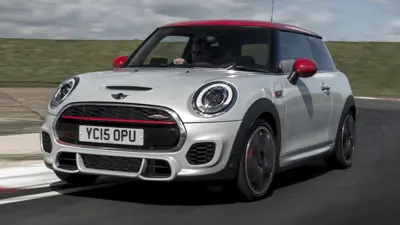
Hatchback JCW (2015)
The Mini John Cooper Works (JCW) is a fun-to-drive performance version of the hatchback
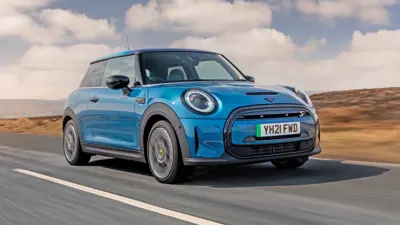
Hatchback Electric (2020)
The Mini Electric is a stylish small car that’s fun to drive and cheap to run

